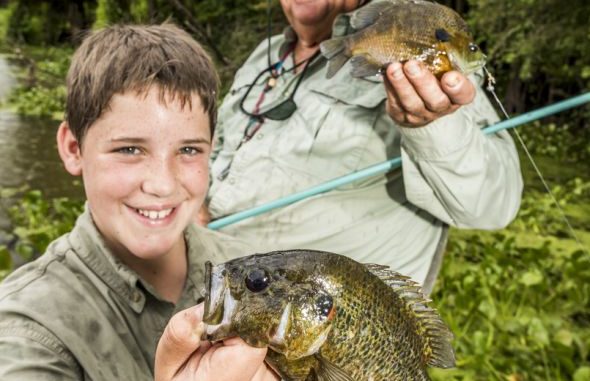
Learn how this certified bream killer consistently catches boxes of fish
Louisiana Sportsman contributor Jerald Horst has a reputation as a serious bream killer. I’ve repeatedly heard stories of him returning to the landing with hundreds of bluegill and goggle-eye.
“My goal is 200,” Horst confirmed when he called and invited me to join him and his grandson on a trip yesterday to the sprawling Atchafalaya Basin. “If I don’t catch 200 it’s not a good trip.”
The forecast was not promising with a 70 percent chance of rain. When I woke up and checked the radar, there already were storms south of Morgan City.
Nevertheless, we loaded up rain suits and headed into the swamp — and got dumped on most of the day.
But I couldn’t have had more fun or caught more fish.
Horst complained most of the day that “this isn’t the fishing I’d hoped for,” but when we headed back our count was 213 bream, three catfish and a couple of bass.
Not bad for a day during which we spent most of the time huddled in our rain suits and watching our corks jostled around by rain drops.
So how does he consistently ice so many bream? Here are six tips I learned from Horst:
• Use jig poles — Bream fishing is simply not the time to pull out casting equipment, this die-hard bream killer insisted.
“With jig poles, I can get to places the fishermen with casting rods can’t get,” Horst said. “Oh, they might be able to get into it, but they’re more likely to hang up.”
That’s because jig poles allow an angler to lift his bait straight up instead of dragging it across bottom debris.
And once you drag grass or a stick across a bed, catching another fish from that spot become impossible, he said.
Horst prefers 10-foot telescoping rods (think B’N’M or Salter’s Jig Poles) so he can keep his boat away from his targets.
When using the B’N’M type of rods, the key is to have a working length of line that matches the rod’s length so you can just flip the rig under overhanging branches.
His grandson, 11-year-old Jake Gros, prefers a Salter’s Jig Pole, which allows him to pull the cork all the way to the tip and stick his bait in tight holes or flip a cricket out farther than his grandfather by simply feeding more line.
• Real corks — Styrofoam corks are available in pretty much any store selling fishing equipment, but Horst goes out of his way to find real cork bobbers. His favorites are sold by Mepps, and he orders them from the factory.
“They don’t want to sell them to me because they would rather me go through their local distributors, but no one around me sells them,” Horst said.
What these real corks do is telegraph everything that’s happening on the business end of the line.
“I don’t think those foam corks are as sensitive,” Horst said. “With these (real) corks, you see every little movement.”
Indeed, most of the bites from bull bream were so subtle on this trip that the cork never really moved as much as trembled.
Horst also said real corks stand up in the water much better than foam versions. Just be sure you have enough weight crimped on your line.
There are several sizes, but Horst uses 00 corks.
• Keep dapping — I learned to bream fish from my parents, who will let a cricket sit for several minutes before moving to another spot.
That’s a big mistake, Horst said.
“You have to keep moving your bait,” he said. “We call it ‘dapping.’ You pick it up and put it back down. Just keep moving it. Never let it just sit.”
The method allows him to cover a lot of water and up his odds of running across beds, but Horst said he’s also convinced the fish hear the sound of that cork plopping onto the surface — or “dapping” — and will come to investigate.
“It sounds like a bug hitting the water,” he explained. “I think that dapping sound attracts the fish.”
• X marks the spot — Whenever a bull bream is caught, it’s important to put another cricket in the same spot to determine if there is a bed there.
“You have to be watching and put it in the exact spot,” Horst said. “Every now and then you’ll catch a roamer, but there are often fish on the beds and you can catch numbers from one spot.”
• Be ready to set anchor — I was mystified when handed a small anchor and told to tie it off to something in the rear of the boat. And then I watched as Horst tied off another anchor to his seat pedestal up front.
But then it all became clear.
“You have to be ready to anchor the boat to keep it from getting pushed onto a (bream) bed,” Horst explained.
But he doesn’t anchor every time he gets a bite.
“My rule is that you have to catch two fish from the same spot,” he said. “If we catch two fish from the same spot, we ease the anchor over and work that area over until the bite plays out.”
Once crickets are ignored — or the fish get tiny — the anchors are pulled, and Horst moves on using his trolling motor.
• Use fish baskets — Horst places great importance on keeping fish iced down, so he carries a lot of ice. As in several ice chests full.
“You can’t have too much ice,” he said.
OK, so if he’s carrying multiple boxes of ice, why in the world would he use fish baskets hanging over the gunwale of his boat?
The answer is simple: He wants to ensure his ice doesn’t melt.
“Whenever you open and close the ice chest, you’re melting your ice,” Horst said. “So I just put the fish in a basket until I’m ready to move. Then I open the ice chest once to put all my fish into the ice chest.”
He carries one empty ice chest, and once he’s ready to cool fish down, he layers fish between ice.


